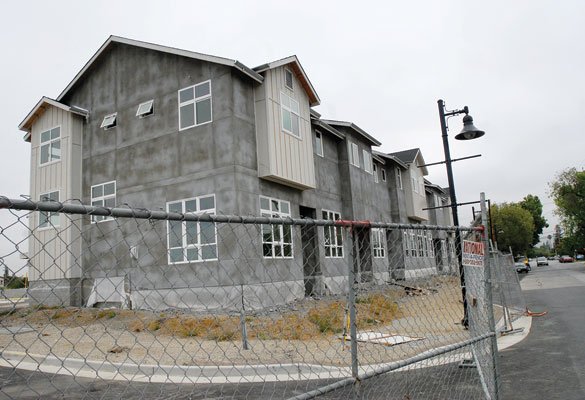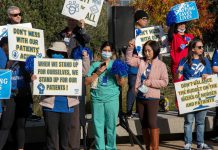The city has collected $13.8 million less from developers than
expected so far this fiscal year, according to city figures.
When the fiscal year ends June 30, city coffers dedicated to
building new roads, sewer lines, water pipes and public buildings
such as the planned arts center and new library will likely have
about $4.4 million, down from the $18.2 million that officials
projected last year.
The city has collected $13.8 million less from developers than expected so far this fiscal year, according to city figures.
When the fiscal year ends June 30, city coffers dedicated to building new roads, sewer lines, water pipes and public buildings such as the planned arts center and new library will likely have about $4.4 million, down from the $18.2 million that officials projected last year.
Larger fund totals are larger because they include account balances forwarded from previous years, earned interest and grant money, but officials say this year’s 75 percent shortfall will equal 50 percent next fiscal year and 25 percent the year after: City Engineer Rick Smelser and Community Development Director Wendie Rooney said they expect the development-driven fees to rebound by fiscal year 2010-11.
Last calendar year the city’s development department issued 112 building permits for new residential units. Developers usually pay their impact fees when they pull their permits, but so far this year, the city has only issued two permits for as many pre-bought, custom-built homes that are not part of a larger subdivision.
“The current downturn in the economy has severely slowed development and reduced current impact fee revenues for this fiscal year by nearly 75 percent,” City Engineer Rick Smelser told the city council, Planning Commission and Parks and Recreation Commission last week. He and Community Development Director Wendie Rooney have both stressed, however, that this money is not lost.
The so-called impact fees pay for the construction of new water pipes and new roads that accompany new development – not the repair or maintenance of existing infrastructure.
“It’s not like we’ve lost this money; it’s just deferred. When development actually does pick up and come in again – and it will – then we will get the fees,” Smelser said.
The immediate effect the lack of funds will have is to delay funding for projects such as the arts center or the new library, Rooney said.
“The struggle for us means we just have to look at our capital program and readjust it. Many projects will be pushed back because there is not enough revenue to offset the shortfalls,” Rooney said. “The good side to this, though, is that the developers are also not building, so the cycle and the process work when we’re really busy and when we’re not.”
Rooney also pointed to grants such as the $6.7 million the city received from the Valley Transportation Authority to build the new Camino Arroyo at Ronan Channel.
“We’re staying on top of it and watching the situation carefully, but it’s not unexpected given the building slowdown,” Rooney said.
When Rooney and other staff members present their recalculations to the council May 19 during a study session, Mayor Al Pinheiro said the body will then be able to adjust funding means for the downtown arts center and library. He stressed, though, that when the city bought Gilroy Gardens earlier this year, staff specifically earmarked $8.8 million for 2012 and another $7.2 million for 2015 to partially fund the arts center and library, respectively. Both projects will likely cost much more based on previous readjustments, but the council could always make additional changes or recommend selling bonds to finance the projects.
“It’s too early and too premature for us to say what kind of impact the current slowdown will have because we haven’t looked at all of our options yet,” Pinheiro said.
The average low-density house brings in about $51,000 in fees for the city, and city employees then allocate that money to the different funds: The public facilities pot – which funds improvements for parks, police, fire and city facilities – gets about 42 percent of every dollar, the largest share, and storm development and street trees get just more than 1 percent.
Local solar home builder Chris Cote just finished construction of his project at the corner of Hanna Street and Gurries Drive has since floated the idea of expanding eligibility for the city’s $300,000 home loan pot. The loan program offers $20,000 to $50,000 to pre-approved Gilroy residents with moderate-or-below incomes and city and Gilroy Unified School District employees, all of whom must be first-time home buyers. By expanding this pool of applicants and encouraging loans for new homes instead of existing ones, property values could rise as a result of more activity that would then encourage fee-paying developers, Cote wrote in an e-mail to Housing and Community Development Coordinate Marilyn Roaf.
“Since they are cutting all capital improvements now by 70 to 80 percent with impact fees falling off commensurately, my plan is to use existing city resources to stimulate the new home market,” Cote wrote in a separate e-mail. “The more new homes built the more fees generated.”
Roaf was not sure about Cote’s theory, and she noted that the funding for the loan program comes from the sale of below-market-rate units, so “its purpose is to make sure the beneficiaries (loan recipients) are the low- to moderate-income folks.” The city council would have to tweak the loan program’s rules, she said.
Either way, the larger economy remains beyond the city council’s reach.
“When the impact fees start coming in again, we can speed things back up,” Pinheiro said.
Impact fee funds
ThenNow
Storm drain59,75415,844
Underground utilities173,000 183,355
Street trees8,2501,000
Traffic6,806,9172,130,503
Sewer3,243,534657,186
Water1,305,191222,400
Public facilities6,631,9001,232,092
Totals18,228,5464,442,380
Source: City of Gilroy FY 07-08














